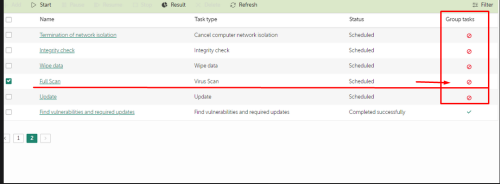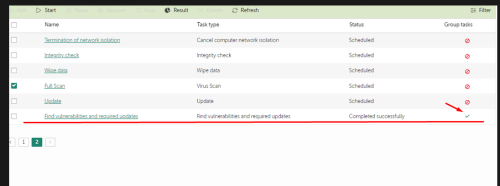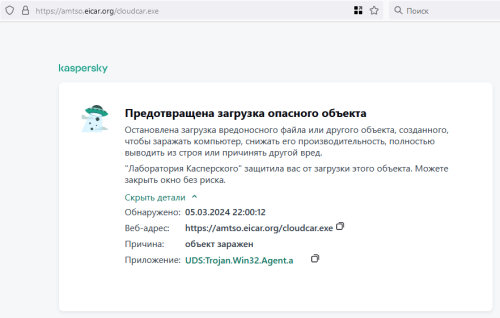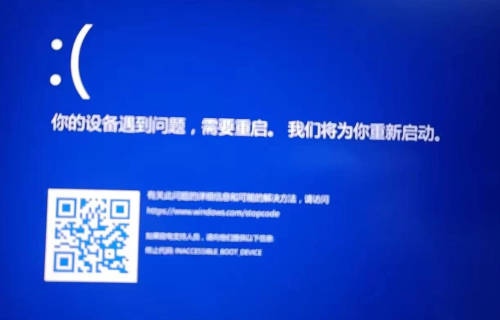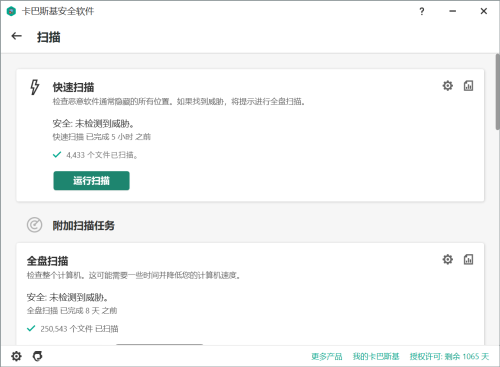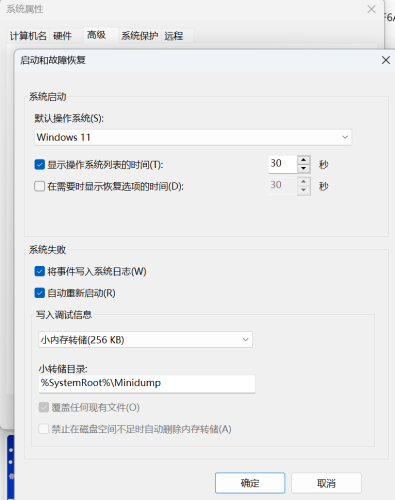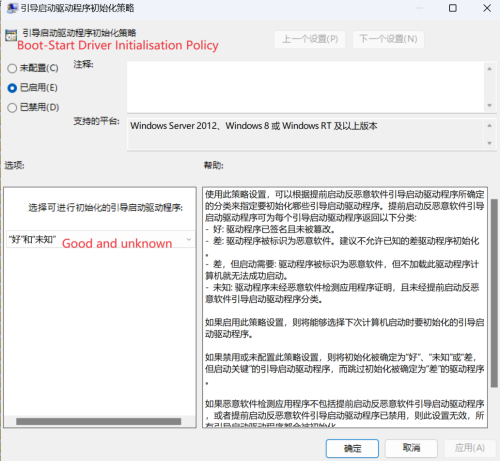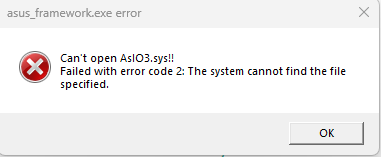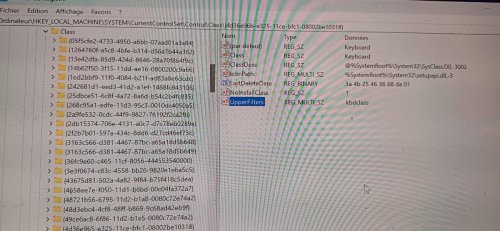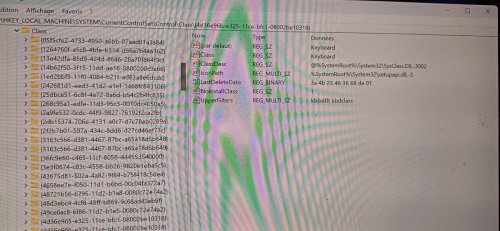Search the Community
Showing results for 'Quick Launch Keyboard'.
-
I installed Kaspersky Antivirus and my mouse and keyboard stopped working after restarting. I am trying to fix the problem using Kaspersky Rescue Disk 18 but it only shows a black screen after choosing “Graphic Mode” or “Limited Graphic Mode”. I have an Nvidia Geforce RTX 4070 graphics card. I tried to use this topic as a solution, however the link sent for KRD 2024 beta did not work. I can’t use my keyboard or mouse, I cannot run KRD since it gives me a black screen, and I can’t find recovery mode either. My PC is basically useless. Please help
-
Keyboard and mouse not working after restart
demirelab replied to demirelab's topic in Kaspersky Total Security
Hello, Unfortunately I cannot do that without my keyboard or mouse. -
I installed Kaspersky Total Security today, with a one year subscription. However, after it did a scan and restarted the computer, my keyboard and mouse have stopped responding. I tried other keyboards and mice, both wired and wireless as well but it did not work. But they still work on the biOS screen of the pc. I could not find a recovery boot option. So I would like to have help with this.
-
Danke Schulte, werde es beobachten, ab wann die Meldung wieder kommt. Kann etwas dauern, bin nicht täglich am Rechner. Mein letzter download war von der Seite ITSG, einem Sozialversicherungsmeldeportal der deutschen Sozialversicherung. Melde mich, sobald der "quick driver updater" wieder auftaucht.
-
Hallo! Habe soeben erstmals Kaspersky auf meinem Rechner installiert, der Grund war, dass am rechten unteren Bildschirmrand ein kleines quadratisches Fenster aufging mit der Meldung "quick driver update" - ich halte das für einen Virus oder sonstigen Trojaner oder Müll. Nach der Installation und vollständiger Systemprüfung erscheint das Fenster immer noch. Es lässt sich mit dem Task Manager unter "task beenden" wegklicken. Weiss jemand, was das "quick driver update" ist? - ein Virus, Trojaner, sonstwas?
-
can't make full scan for some pc
ElvinE5 replied to iizo6's topic in Kaspersky Endpoint Security for Business
I'll assume that you are trying to run a standard LOCAL task on a specific device. When the devices are managed by the KSC server, this task on the client devices... seems to be disabled... create a GROUP task in the appropriate section (policies and tasks), specify the necessary settings, select the devices on which it should run, set a launch schedule and try to run it... -
Если кто-то желает убедиться в активности облачной защиты после отключения участия в KSN, существует тестовый сайт AMTSO. По ссылке кликаете на кнопку "Launch the test". В зависимости от настроек АВ, сработает либо веб-защита (когда включена проверка защищенных соединений и браузер поддерживается), либо после загрузки файл будет детектироваться файловым антивирусом (из-за оптимизации проверок, возможно, потребуется открыть папку с файлом и подождать или просто попробовать просканировать файл через контекстное меню). Префикс UDS (Urgent Detection System) в детекте как раз говорит о том, что срабатывает облачная защита. На всякий случай еще раз: ссылки и файлы на сайте не являются вредоносными и предназначены для проверки работоспособности компонентов защиты.
-
FTP files uploaded seems to sent fast but got timeout
kabeda replied to kabeda's topic in Kaspersky: Basic, Standard, Plus, Premium
Hi, Thanks for your quick answer. Unfortunately, it doesn't correct my problem. Obviously, I tried once again to disable AV and upload. The problem is still here. I was too quick in my conclusions to think the VA was the culprit. -
First I can't get my screen to print. If it makes sense to you I have an ASUS keyboard and a dell computer. I have tried the print scr and the alt and F7 key nothing. Windows: 22H OS BUILD 19045.4046 Chrome: 122.0.6261.95 official build 64bit As far as Kaspersky I can't get anything on that. I right click it only shows pin to start, more, history, settings, data base, tools and scan. Run error Failed to run Protected Browser. Reason: Process was stopped. I can only run safe money in firefox. Chrome and microsoft edge can't do.
-
Tweaks y preguntas sobre kaspersky security cloud
Khanerl replied to Khanerl's topic in Para usuarios particulares
Hi i recently installed kaspersky security cloud i have some cuestions 1.- The licence is perpetual or only for 1 year or 5 years. 2.- Tweaks for perfomance whitout risk security. 3.- Tweaks for maximum security. 4.- Have anipishing protectio i dont see the brwoser plug in 5. Why the full scan is too quick in nvm2 runs in less than one hour and other products delaay 3 hours. 6.- Have any advantage than defender really? -
Bluescreen: INACCESSIBLE_BOOT_DEVICE with KIS 21.3.10.391 and ELAM Turned On
Piyi Zu replied to Piyi Zu's topic in Kaspersky Internet Security
I tried to figure out why. But I found nothing in the "Event Viewer", "Security and Maintenance" and minidump folder. I checked the digital signatures for every driver before installing. The driver installation packages were scanned by Microsoft Defender before KIS was installed. All drivers, including the firmware are up-to-date. I thought it were a hardware problem, but that couldn't explain why I can still start Windows after shutting down ELAM. I thought it were caused by corrupted system file, but after executing dism /online /cleanup-image /scanhealth dism /online /cleanup-image /restorehealth sfc /scannow no integrity variation was found. I thought it were caused by virus, but I ran a quick scan just before the failed reboot. Those are what I did and saw before updating KIS. ELAM stage is a very early boot stage. It's like when a baby having just learnt to say mummy. To debug the OS may find the cause, but it's beyond my time, energy and ability. If the bsod were caused by KIS, the most possible "solution" would still be to update it. If it were caused by some damn driver, then updating KIS would have no help. -
Bluescreen: INACCESSIBLE_BOOT_DEVICE with KIS 21.3.10.391 and ELAM Turned On
Piyi Zu posted a topic in Kaspersky Internet Security
My computer is running Windows 11 23H2 22631.3155 Professional (x64) and has Kaspersky Internet Security 21.3.10.391 (patch k) installed. After a quick scan of kaspersky, I restarted my computer but failed with a bluescreen. It said the OS ran into some problem and the error code was INACCESSIBLE_BOOT_DEVICE. After a forced reboot, the same bluescreen appeared again. I tried Windows boot repaire but it didn't work. I couldn't start the computer until I disabled the Early-Launch-AntiMalware on the boot option menu, which resulted in KIS not loaded. I thought the bluescreen must have something to do with KIS. To prevent rootkits and other unknown drivers from being loaded when the system boots, just after I had installed my OS, I turned on the Boot-Start Driver Initialisation Policy in Group Policy and set the policy to only allow "good" drivers to be initialised. I changed the policy to allow "good and unknown" drivers and restarted the computer, there was no bluescreen and KIS started normally like before. I changed the policy back to only allow "good" drivers and restarted the computer, the bluescreen came again. Just before this bluescreen accident happened, I updated database of KIS, and I ran a quick scan (NOTHING detected). I installed Qt 6.5.3 several days ago, but nothing went wrong these days. Even earlier, I installed a driver for Lenovo Hotkey on Lenovo System Update, which is an official driver updater and the installation was fully monitored by Kaspersky Internet Security. I think the problem may be due to KIS incorrectly classifying some important driver to be unknown during the ELAM stage. But I could not find anything about it: no related event logged, no KIS report and even no dump file for the bluescreen. The compromise in ELAM policy is just a workaround. Could anyone give more help? -

System audit tasks cannot be performed
Flood and Flood's wife replied to Riddick's topic in Kaspersky: Basic, Standard, Plus, Premium
Hello @Riddick, Welcome! Good work doing the *extra* troubleshooting. Was the last PC *shutdown* normal? Is Kaspersky Premium configured to launch at computer start-up? What is the full Windows 10 OS & Build, in Windows Search - type WINVER - post back the results from the winver app please? Run a Database update - allow it to complete. Shutdown the PC using SHUTDOWN, not Restart, power on by pressing the power button, login, make sure Kaspersky is running & recheck System Audit for: Safe Browsing? Mail Anti-Virus? Firewall, Error? Network Attack Blocker? Please post back? Thank you? Flood?+? -
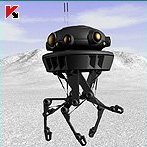
Kaspersky Total Security - Crash on specific disk scan
Berny replied to Cjaker's topic in Kaspersky Total Security
@Cjaker Welcome. Please see → Application "crashes", "freezes" or "lags"; the "Previous application launch failed" error message appears Did you provide a GSI Log to Kaspersky Technical Support ? Also, please check your Window Event Log ? Additionally please see → Kaspersky: Basic, Standard, Plus, Premium - info & FAQ → Q1- 1 reply
-
- 1
-

-
Error code 2: File Not Found - AsIO3.sys!!
Erencan replied to Erencan's topic in Kaspersky Internet Security
Thank you for your quick feedback. I will get back to you after trying the solutions. -
I just updated my pc and can't run Armory Crate or install AsusAI suite due to no AsIO3.sys file installed. Armory crate installs but doesn't launch. AISuite won't install at all. I tried reinstall it but didnt work. I think its caused by KIS. Most likely, the KIS detects this file as a threat. Any solutions for this or is it just need to be update? Win 11 23H2
-
Hello. I just installed Kaspersky internet security and right away my Lenovo yoga 7i keyboard stopped working. Tried several methods before finding the registry method. Problem is, I follow all the steps, I delete the "klkbdflt" entry from the registry leaving only "kbdclass". I hit ok. Then when I close the registry, it comes back as it was: both entries appear in the UpperFilters. What do I do now? Please help, I need this machine for work. When I change it: When I open it again:
-
 Advice and Solutions (Forum Knowledgebase) Disclaimer. Read before using materials. SNMP daemon on SVM should have the following default settings: protocol version: v2c rocommunity name: public listening address and port: 0.0.0.0:161 access type: read only transport: UDP logging: syslog The following statistics can be received from SVM: # Description Name Identifier 4.1 CPU Statistics UCD-SNMP-MIB::systemStats 4.2 Memory Statistics UCD-SNMP-MIB::memory 4.3 Load average statistics UCD-SNMP-MIB::laTable 4.4 Disk statisitcs HOST-RESOURCES-MIB::hrStorageTable 4.5 Network statistics IF-MIB::ifTable 4.7 Amount of desktop VMs connected KSVLA-MIB::ksvlaProtectedDesktopCount 1.3.6.1.4.1.23668.1491.1539.1.1 4.8 Amount of server VMs connected KSVLA-MIB::ksvlaProtectedServerCount 1.3.6.1.4.1.23668.1491.1539.1.0 4.9 ODS running status: - in progress (if all ODS Tasks are running) - waiting (if at least one ODS task is waiting for processing) - none (if no ODS tasks are running/waiting at all) KSVLA-MIB::ksvlaODSStatus 1.3.6.1.4.1.23668.1491.1539.0.0 4.10 ODS queue lenght: amount of VMs awaiting ODS processing KSVLA-MIB::ksvlaODSQueueLenght 1.3.6.1.4.1.23668.1491.1539.0.1 4.11 Amount of simualtaneously running ODS tasks KSVLA-MIB::ksvlaODSTaskCount 1.3.6.1.4.1.23668.1491.1539.0.2 4.12 Current percent of an allowed physical memory consumption - In case of watchdog is on use WDSERVER_MAX_MEM const from ScanServerLaunch.sh as maximum - In case of watchdog is off use 100% as maximum KSVLA-MIB::ksvlaMemoryConsumption 1.3.6.1.4.1.23668.1491.1539.3.0 4.13 Current percent of an allowed swap consumption - In case of watchdog is on use WDSERVER_MAX_SWAP const from ScanServerLaunch.sh as maximum - In case of watchdog is off use 100% as maximum KSVLA-MIB::ksvlaSwapConsumption 1.3.6.1.4.1.23668.1491.1539.3.1 4.14 Main processes state (running/stopped): -- scan server daemon KSVLA-MIB::ksvlaScanServerStatus 1.3.6.1.4.1.23668.1491.1539.2.0 -- klnagent daemon KSVLA-MIB::ksvlaKlnagentStatus 1.3.6.1.4.1.23668.1491.1539.2.1 -- nginx daemon KSVLA-MIB::ksvlaNginxStatus 1.3.6.1.4.1.23668.1491.1539.2.2 -- watchdog KSVLA-MIB::ksvlaWatchdogStatus 1.3.6.1.4.1.23668.1491.1539.2.3 Change SNMP community name Edit file /etc/snmnp/snmpd.conf Change public into the string recommunity on your own Save changes Restart SNMP daemon - systemctl restart snmpd Move on SNMPv3 Stop SNMP daemon - systemctl stop snmpd Launch the command - net-snmp-config --create-snmpv3-user -ro -a "authpass" -x "privpass" -X AES -A SHA "user" "authpass" is the private key/password for generating HMAC when connecting to snmpd, "privpass" is the private key/password for encrypting snmp traffic, "user" is the username for snmpd. "authpass" and "privpass" we can say passwords, which should be generated by you own "user" - user name for snmpd This command will make mpdifications into two files - /etc/snmp/snmpd.conf and /var/lib/net-snmp/snmpd.conf Restart SVM
Advice and Solutions (Forum Knowledgebase) Disclaimer. Read before using materials. SNMP daemon on SVM should have the following default settings: protocol version: v2c rocommunity name: public listening address and port: 0.0.0.0:161 access type: read only transport: UDP logging: syslog The following statistics can be received from SVM: # Description Name Identifier 4.1 CPU Statistics UCD-SNMP-MIB::systemStats 4.2 Memory Statistics UCD-SNMP-MIB::memory 4.3 Load average statistics UCD-SNMP-MIB::laTable 4.4 Disk statisitcs HOST-RESOURCES-MIB::hrStorageTable 4.5 Network statistics IF-MIB::ifTable 4.7 Amount of desktop VMs connected KSVLA-MIB::ksvlaProtectedDesktopCount 1.3.6.1.4.1.23668.1491.1539.1.1 4.8 Amount of server VMs connected KSVLA-MIB::ksvlaProtectedServerCount 1.3.6.1.4.1.23668.1491.1539.1.0 4.9 ODS running status: - in progress (if all ODS Tasks are running) - waiting (if at least one ODS task is waiting for processing) - none (if no ODS tasks are running/waiting at all) KSVLA-MIB::ksvlaODSStatus 1.3.6.1.4.1.23668.1491.1539.0.0 4.10 ODS queue lenght: amount of VMs awaiting ODS processing KSVLA-MIB::ksvlaODSQueueLenght 1.3.6.1.4.1.23668.1491.1539.0.1 4.11 Amount of simualtaneously running ODS tasks KSVLA-MIB::ksvlaODSTaskCount 1.3.6.1.4.1.23668.1491.1539.0.2 4.12 Current percent of an allowed physical memory consumption - In case of watchdog is on use WDSERVER_MAX_MEM const from ScanServerLaunch.sh as maximum - In case of watchdog is off use 100% as maximum KSVLA-MIB::ksvlaMemoryConsumption 1.3.6.1.4.1.23668.1491.1539.3.0 4.13 Current percent of an allowed swap consumption - In case of watchdog is on use WDSERVER_MAX_SWAP const from ScanServerLaunch.sh as maximum - In case of watchdog is off use 100% as maximum KSVLA-MIB::ksvlaSwapConsumption 1.3.6.1.4.1.23668.1491.1539.3.1 4.14 Main processes state (running/stopped): -- scan server daemon KSVLA-MIB::ksvlaScanServerStatus 1.3.6.1.4.1.23668.1491.1539.2.0 -- klnagent daemon KSVLA-MIB::ksvlaKlnagentStatus 1.3.6.1.4.1.23668.1491.1539.2.1 -- nginx daemon KSVLA-MIB::ksvlaNginxStatus 1.3.6.1.4.1.23668.1491.1539.2.2 -- watchdog KSVLA-MIB::ksvlaWatchdogStatus 1.3.6.1.4.1.23668.1491.1539.2.3 Change SNMP community name Edit file /etc/snmnp/snmpd.conf Change public into the string recommunity on your own Save changes Restart SNMP daemon - systemctl restart snmpd Move on SNMPv3 Stop SNMP daemon - systemctl stop snmpd Launch the command - net-snmp-config --create-snmpv3-user -ro -a "authpass" -x "privpass" -X AES -A SHA "user" "authpass" is the private key/password for generating HMAC when connecting to snmpd, "privpass" is the private key/password for encrypting snmp traffic, "user" is the username for snmpd. "authpass" and "privpass" we can say passwords, which should be generated by you own "user" - user name for snmpd This command will make mpdifications into two files - /etc/snmp/snmpd.conf and /var/lib/net-snmp/snmpd.conf Restart SVM -
Guilhermesene, thanks for your reply. Very quick question is that the memory integrity box you suggest I uncheck is already unchecked ie showing as off. Whether the upgrade has changed this or whether this has always been the case I don`t know. Do you think checking or turning it on may help or should I give it a try? Thanks a lot.
-

Secure browser, premium (although it's not really premium).
Schulte replied to Stan_natS's topic in Kaspersky: Basic, Standard, Plus, Premium
Hello @Stan_natS, how did you create the screenshot? The function using the 'PrtScr' key is permitted. This means that someone is sitting at your computer and operating the keyboard. Only the creation of a screenshot that is triggered by software should be prevented. -
Kaspersky Internet Security Block Brave Browser Every First Launch
Sothyro posted a topic in Kaspersky Internet Security
Dear KIS Community I don't know why KIS block Brave Browser every first time launch it. When start browsing, it is blocked. Second time of launch it I can browse. Moreover, If I exit my second times browser window then third times is not work too. Unless reopen it (4th). Error by the following action like this. Moreover, I can't find the solution of such this case over Google also. Please help. If the problem still exist, might not renew license. Really bored. -
great now my kaspersky wont launch any more , after the update
-
Quick fix: You can use OpenVPN Connect with configuration for router. https://my.kaspersky.com/VPN#/portal/pages/ksec
-
Kaspersky prevents Windows from going to sleep properly
StePits replied to automaker's topic in Kaspersky Free
Laptop Lenovo Legion win11 23H2 Kaspersky Premium. Trouble waking up after sleeping. Sleep state: Standby (S3). Only one power plan that is Balanced (and after powercfg -restoredefaultschemes). Sfc /scannow OK Note: I have an external mouse and keyboard that allow the system to wake up. The strange thing I have noticed. When I put it in sleep mode, it wakes up normally. When I leave it alone without work (Balanced option), and it "sleeps" it does not wake up. Perhaps I notice that this is a different sleep. In force sleep everything turns off and the Power button flashes. In the second case it's like the fans are running and the Power button is solidly on. (Here it does not wake up and is forced to power off). (Hibernate is OFF) -

kapersky threat intelligence giving "not categorized detections"
MRnutty200 replied to MRnutty200's topic in Virus and Ransomware related questions
hello You 5.02.2024 23:13 How may i assist you today? Operator 5.02.2024 23:13 i was recently told to make a chat for a problem whit kapersky Threat Intelligence Portal You 5.02.2024 23:13 by a forum master You 5.02.2024 23:13 Okay, let me check on the issue details for you Operator 5.02.2024 23:14 ok You 5.02.2024 23:14 If you could please hold on for 1-3 minutes and I will check for you. Operator 5.02.2024 23:14 ok ill hold You 5.02.2024 23:15 Thank you, please wait Operator 5.02.2024 23:16 Thank you for waiting patiently Operator 5.02.2024 23:18 We are just trying to get more details on this, is that will be okay if I update you with an email within 24hours? Operator 5.02.2024 23:19 ok You 5.02.2024 23:19 We are just trying to get more details on this, is that will be okay if I update you with an email within 24hours? Operator 5.02.2024 23:19 like for messeges? You 5.02.2024 23:19 we will update you on email Operator 5.02.2024 23:19 well yes its okay You 5.02.2024 23:20 Sorry for the inconvenience caused. Operator 5.02.2024 23:20 Is there anything else I can help with before we end the chat? Operator 5.02.2024 23:20 no thats it thank you for the help You 5.02.2024 23:20 No worries. Please take note of the reference number for this chat: INC000016171813 If that is all for now, I will end this chat here and I would appreciate it if you could complete a quick survey about the support that I have provided. ? Thank you for contacting Kaspersky and have a nice day. ? Operator 5.02.2024 23:21 The conversation has been completed. Please feel free
